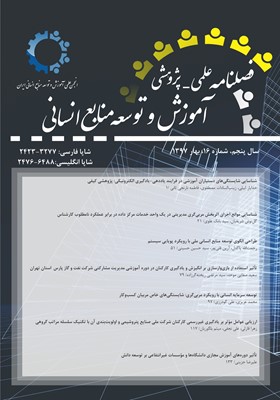کاربست مفاهیم دانش مدیریت آموزشی در سیستمهـای غیرآموزشی (مورد مطالعه: صنعت چاپ و نشر ایران)
محورهای موضوعی :
1 - دانشگاه آزاداسلامی واحد تنکابن
2 - دانشگاه آزاداسلامی واحد تنکابن
کلید واژه: اربست, دانش مدیریت آموزشی, سیستمهای غیرآموزشی, صنعت چاپ و نشر ایران, پدیدارشناسی, کلایزی.,
چکیده مقاله :
هدف پژوهش حاضر بررسی این پرسش اساسی است که با توجه به تغییرات گسترده در تکنولوژی، کدام جنبه از مفاهیم و فرایندهای دانش مدیریت آموزشی، در صنعت چاپ و نشرکاربرد بیشتری دارد و لازم است جهت استقرار یک سیستم آموزشی کارآمد در این صنعت در اولویت قرار گیرند؟ نوع مطالعه کیفی با رویکرد پدیدارشناسی بویژه تحلیل تجربه زیسته بود. مشارکت کنندگان اين پژوهش از طریق نمونهگیری هدفمند از نوع گلوله برفی تا مرز اشباع نظری، 8 تن از صاحب نظران عرصه آموزش های سازمانی و متخصصین و فعالین شناخته شده صنعت چاپ و نشر بودند. در این پژوهش جهت استحکام پایایی تحقیق از قابلیت وابستگی، باورپذیری و تأیید پذیری استفاده شد. دادههای حاصل از بازخوانی مصاحبهها در این پژوهش، با استفاده از روش هفت مرحلهای کلایزی مورد تجزیه و تحلیل قرار گرفتند. براساس نتایج حاصل از کدگذاری، 37 مؤلفه بازشناسی شدند که در 13 موضوع استنباطی قابل خوشه بندی بودند. در نهایت 6 سازه استاندارد سازی بستههای برنامههای درسی، متنوع سازی سیستمهای عرضه آموزش، بسط زیبایی شناسانه آموزش، بازاریابی و برندسازی، لجستیک جامع و مؤثر و نیز پایش مستمر مبتنی بر نرخ بازگشت سرمایه در آموزشهای صنعت چاپ و نشر ایران به عنوان بخشی از مفاهیم دانش مدیریت آموزشی تمیابی شدند. تحلیلهای ارائه شده در این پژوهش نشان میدهد کاربست مفاهیم اشاره شده، بهرهوری صنعت چاپ و نشر را در شرایط تغییرات گسترده درونی و بیرونی این صنعت ارتقاء خواهد داد.
The purpose of this study is to examine the fundamental question with regard to extensive changes in technology, which aspects of the concepts and processes of knowledge management in the Printing and publishing industry are more applicable and need to be prioritized in order to establish an effective teaching system in this industry? The study was a qualitative type with phenomenon approach, in particular survival analysis. The participants of this study were selected through targeted snowball sampling to theoretical saturation boundary, from eight experts, well-known publishers and practitioners. The dependability, credibility and patriotism validity has been utilized to strengthen the reliability of the research. The data from interviews were analyzed using a seven-step Colaizzi method. The results of the coding of 37 components were precipitated and could be clustered in 13 inferential issues. Finally, 6 structures consisting of the following themes were driven, which were recognized in the Iranian printing and publishing industry as part of the concepts of the Knowledge management monastery: Standardization of curriculum packages, Diversification of training supply systems, Aesthetic expansion of the training, Marketing and branding, Comprehensive and effective logistics, Continuous monitoring based on return on capital. The analysis presented in this study shows that the application of the mentioned concepts will enhance the productivity of the printing and publication industry in the face of the wide variations in the internal and external dimensions of this industry.
